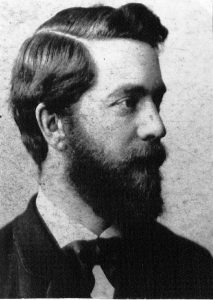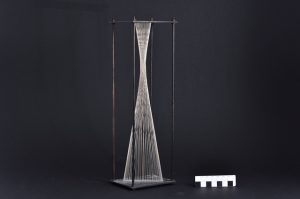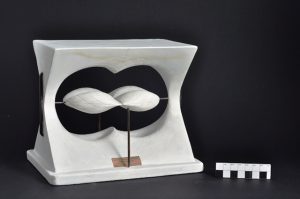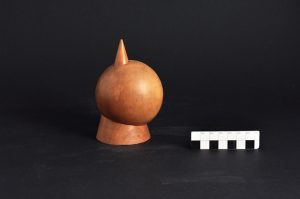Mathematical Collection
The Mathematical Collection at the Department of Mathematics
Introduction
The collection of mathematical models at FAU dates back to Felix Klein, who was appointed to the professorship of mathematics to the local university in 1872. It is said to be the first collection for teaching purposes of this kind in Germany. Mathematical models concretize abstract subject matters. Most of the Erlangen models illustrate geometric issues. The majority of them is made of plaster, few are made of wood, carton, wire, yarn and brass.
Such models flourished in the last third of the 19th century, when many universities strove for more clearness in higher education. From the 1920ies onward these models increasingly lost their importance. As mathematical science became more and more abstract, these models slowly disapeared. The changes in the perception of mathematics and the new, more general approach of transfering math knowledge made these models obsolete. Thus, the illustrative geometric figures fell into oblivion in many places.
This was also true for Erlangen. But as the two institutes of mathematics moved together into the Felix-Klein-Building, parts of the teaching aids already thought lost appeared again. Today, the collection still comprises about 170 items, most of them being permanently displayed in the public showcases of the Felix-Klein-Building.
Regarding Felix Klein

Felix Klein is counted among the most outstanding mathematicians of the 19th century. In 1872, when he was only 23 years of age, he was appointed to a professorship in Erlangen, which he left again two years later. In his inaugural lecture he already emphasized the necessity of a teaching in line with illustrativeness and autonomic learning.
In Klein‘s opinion, the power of abstraction needed in mathematics could only be trained by means of experiencing mathematical illustration and observation. For his “exercises in geometric drawing and modelling” he specially had an art room set up as well as the original collection of models.
Formed knowledge

Mathematical models concretize abstract subject matters, thus embodying entirely different cultures of knowledge.
Manual skills, fashionable materials and also contemporary viewing habits were just as significant for their appearance as were the conventions and fashions of that time with respect to mathematical research.
Most of the Erlangen models illustrate geometric issues. The majority of them is made of plaster, few of wood, carton or of wire, yarn and brass. At the beginning, the models were manufactured by hand, often the students made them themselves. Later on, manufacturing companies took over the production and sold whole series of models, the purchase of which was indeed costly.
Crisis and Boom

The dust which mathematical models have accumulated during the decades of their insignificance nowadays appears to be averted in many places. New technological prospects of electronic data processing led to a renewed interest not only in virtual but also in physical mathematical models. At some universities, such as Berlin, Dresden or Göttingen, the models have found their way back into the current teaching activities.
As illustrative objects for the transfer of geometric knowledge they haven‘t lost in value at all. Additionally, as historical evidence these models represent a part of university history und document – in a very concrete way – a historical state of mathematics.
Abstraction and Aesthetics

In an almost sure way, mathematical models are capable of binding the attention of their viewers. The fascination they are able to provoke even nowadays is owed to their aesthetic attraction. It wasn‘t without any reason that mathematical models repeatedly appeared also in modern and comtemporary art as motifs and exhibition items, e.g. in constructivism or surrealism.
Their aesthetics and the high craftsmanship of their making let them appear to be pieces of art themselves sometimes.

